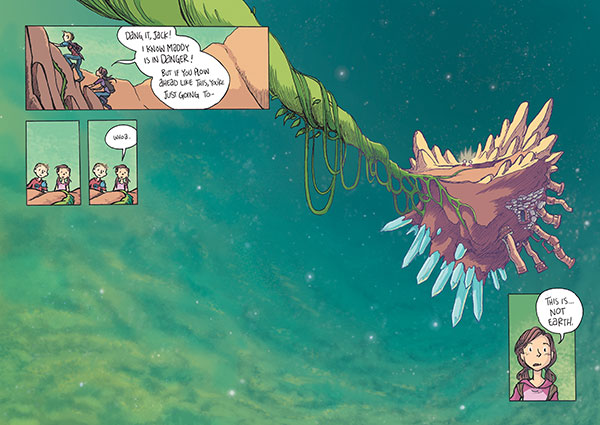 We are thrust into the midst of the action, which never stops until the epilogue. This is how Ben Hatke tells a story.
We are thrust into the midst of the action, which never stops until the epilogue. This is how Ben Hatke tells a story.
We don’t know what’s going on. There’s no setup. Instead, we quickly learn that Jack is climbing some vegetative matter to find the ogre who kidnapped his sister Maddy and take her home. His friend, Lilly, no sidekick, is climbing alongside him.
The villains of the piece are rats, giants, and that ogre. They have control of a nexus point that exists outside of time and space, a connecting link between worlds. It looks like the tower of a castle built on an asteroid. The place has lost its luster because of the giants’ nefarious choices, among them the need to feed a human child to the machine that blocks the bridges between worlds. It’s satisfying to discover these plot points throughout the story.
Jack and Lilly are split up when Lilly falls from the vine (a rat is responsible). Jack vows to come back for her but he is compelled to find Maddy.

The adventure takes off in two directions. Lilly is seriously hurt by the rats … and saved by the goblins who inhabit the lower reaches of the nexus point. The Goblin King demands that Lilly will be his bride. She has other ideas. In the “trash from all worlds,” she finds a Shelby Mustang. She will find a way to take it with her. Lilly is a hero in the truest sense of the word.
The goblins are the most endearing characters in the book. They are funny, resourceful, knowledgeable, and they care for Lilly. Their language is not exactly English and it suits them. Now we know how goblins communicate.
There are unanswered questions. Why can’t Maddy talk? Where did the magic seeds come from that give Jack and Lilly short bursts of needed power? Why is Jack’s mother’s house being foreclosed? These are the intriguing bits that encourage the reader to fill in the story, becoming one with the storyteller.
Hatke’s artwork is so much a part of the story that the book couldn’t be read out loud without showing the frames of the graphic novel. His brain creates exotic settings that invite lingering to absorb their oddness. His villains are dastardly, fearsome, inviting us to defeat them. The goblins are other-worldly but a little cuddly. (Just a little.) The color palette is spacey where appropriate, convincingly subterranean when we’re in the goblin’s habitat, and quite richly appealing when the vegetation transforms. And that Shelby Mustang!
The book is filled with surprises. A turn of the page often brings an unexpected turn of events. Even the epilogue, often used to wrap up a story and tell us about the future, leaves us with a sense of urgency: what will happen next?
There is a first book, Mighty Jack, which I have not read. It most likely creates the world in which Lilly, Jack, Maddy, and Phelix the dragon (!) live, but I’m very glad that a reader doesn’t have to first read that book to enjoy this one. I always hated going to my cousin Sig’s house, reading his comic books, never knowing where the stories were coming from or how they would end because they were published episodically.
This is storytelling at its very best. Appealing, fun, hold-your-breath storytelling. I could have revealed that this is a re-telling of the Jack and the Beanstalk story but it is so much more than that. Ben Hatke’s powers enchant his readers once again.
(Please be advised that this might have a PG13 rating because of some violence and one swear word. You’ll know best if this fits for your family.)
Mighty Jack and the Goblin King
a graphic novel by Ben Hatke
color by Alex Campbell and Hilary Sycamore
published by First Second, 2017
ISBN 978−1−6267−226−68
